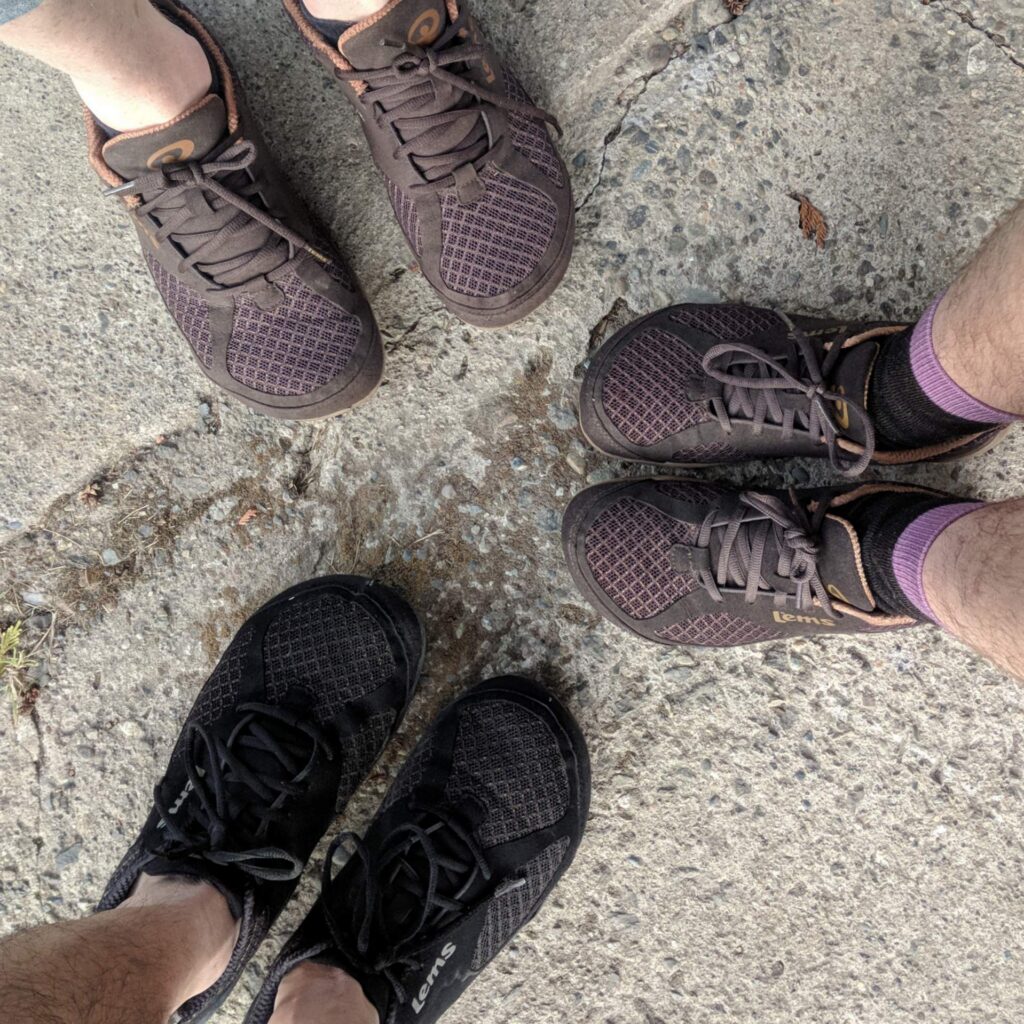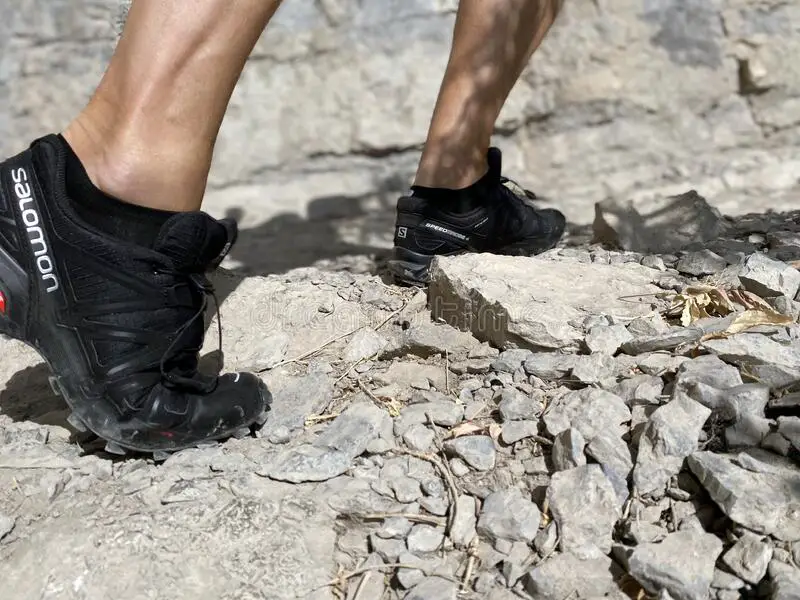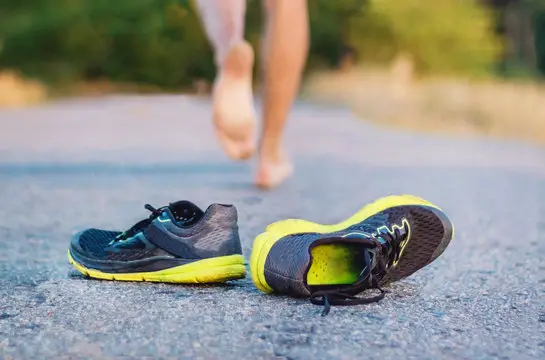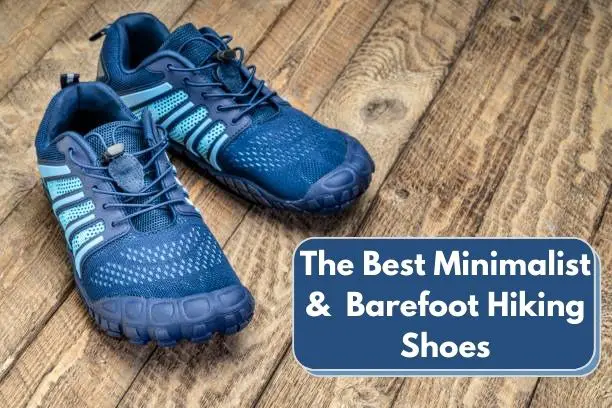With so many hiking footwear options and trends out there, it’s no surprise that many of our readers have been asking if minimalist hiking shoes or barefoot hiking shoes are a good choice for them.
With that question in mind, we set out to create this comprehensive guide where we reviewed the best minimalist hiking shoes and barefoot hiking shoes on the market today, along with what to look for when making your selection.
Read on for more info.
The Best Minimalist Hiking Shoes And Barefoot Hiking Shoes Available Today
| Best Overall Minimalist Hiking Shoes | Xero Xcursion Minimalist Zero Drop |
| Best Waterproof Minimalist Hiking Shoes | Merrell Moab 2 GTX |
| Best Minimalist Hiking Shoes For Arch Support | New Balance Minimus 10v1 |
| Best Sneaker-Style Minimalist Hiking Shoes | Teva Arrowood 2 Waterproof Minimalist Hiking Shoes |
| Best Barefoot Hiking Shoes | Oranginer Barefoot Minimalist Hiking Shoes |
Xero Xcursion Minimalist Zero Drop Waterproof Hiking Boots

The Xero Xcursion Minimalist Hiking Shoes topped our list because they pack everything you’ll need into one relatively affordable hiking boot.
These are lightweight at only about 12-14 ounces each, a zero drop sole that promotes posture, balance, and agility, and the wide toe box offers plenty of comfort and protection against blisters.
The soles are nice and grippy thanks to the dual-chevron tread and 4mm lugs, and the FeelTrue sole feature gives the perfect combination of feedback and protection.
They’re also fully waterproof, with both a water-resistant outer membrane and a seam-sealed bootie.
Why We Like It:
-Sole is grippy and protective
-Wide toe box promotes comfort (rare in minimalist hiking shoes)
-Fully waterproof makes these great for all kinds of weather
-Highly durable and incredible quality
Merrell Moab 2 GTX Men’s Minimalist Hiking Shoes

Although they’re a little meatier than other selections on this list, the Merrell Moab 2 GTX Minimalist Hiking Shoe is a favorite due to it’s excellent waterproof qualities thanks to a waterproof GORE-Tex membrane in the boot.
They feature a Vibram TC5+ outsole, which offers outstanding traction on almost any type of terrain.
These boots have plenty of underfoot cushioning, insoles with great arch support, and are breathable, keeping your feet dry in any situation.
The boot also features an EVA midsole which is great at shock absorption.
Why We Like It:
-Waterproof membrane and breathable materials keep your feet dry in wet conditions
-Kinetic Fit Base EVA footbed provides much-needed heel support
-Vibram TC5+ outsole offers great traction on plenty of terrain types
-Full-grain leather upper is highly durable
New Balance Minimus 10v1 Minimalist Hiking Shoes

The New Balance Minimums 10v1 minimalist hiking shoes feature durable upper materials paired with a Vibram outsole to provide a natural feel while promoting grip on a variety of surfaces.
There’s a shaft that runs from the low-top to the arch for needed support, and the 4mm drop offers a very minimal feel tot he sole with plenty of flexibility, but offers protection too.
These shoes run a little wider than other minimalist hiking shoes, making them better fitted to hikers with flat or wide feet.
Why We Like It:
-Extra grippy Vibram outsole
-Support in the form of an embedded shaft
-4mm minimalist drop for real feel action
Teva Arrowood 2 Waterproof Minimalist Hiking Shoes

Although the Teva Arrowood 2 features more of a traditional thickness sole than most minimalist hiking shoes, it checks so many of the right boxes that we felt compelled to include it on this list.
They feature a super light and durable Float-Lite sole, and waterproof leather uppers seal out moisture to keep your feet dry.
The outsole is high-patterned and extra grippy, with pods strategically placed for extra traction where it’s most needed.
They’re not lacking in the comfort department either, with EVA foam footbeds providing extra cushion which helps you to keep the hike going even longer.
Why We Like It:
-Ultra light padded soles
-Extra comfort where it’s needed
-Waterproof makes them great for wet trail conditions
Oranginer Barefoot Minimalist Hiking Shoes

The Oranginer Barefoot minimalist hiking shoes are aptly named, as they were inspired by barefoot hiking and walking.
As such, they’re extremely flexible and absurdly lightweight, and the synthetic mesh uppers and insoles offer plenty of breathability.
There’s a wide toe box design to allow your toes to spread out and relax naturally, offering you better comfort and stability during climbs and descents.
Overall, these are a great pair of near-barefoot hiking shoes for anyone who is looking to increase their feedback on the trail or who may be considering a full transition to barefoot hiking.
Why We Like It:
-Very minimalist feel, extremely flexible and lightweight
-Offer feedback and support where needed
-Extremely affordable

Minimalist Hiking Shoes Vs Traditional Hiking Boots
You may be wondering what the differences are between hiking boots and minimalist or barefoot hiking shoes.
The differences are pretty important, and can make a big impact on which one is your best bet.
Ankle Support
Depending on your hiking experience and support needs, you may need extra ankle protection when hiking.
Most minimalist hiking shoes do not offer much for ankle support, making traditional hiking boots the winner here.
Weight
Although there’s been a lot of advancement in engineering and materials in the past few years, traditional hiking boots are simply much heavier than minimalist hiking shoes, and you’ll start to feel that difference on longer hikes.
Choose a minimalist or barefoot hiking shoe if you like feeling nimble on your hikes.
Trail Conditions
If your hike will take you through rough, rugged terrain or up and down steep inclines and declines, it’s hard to beat a traditional hiking boot.
Although many of the best minimalist hiking shoes we reviewed in this guide have soles that offer good traction and grip, they don’t have lugs as large as hiking boots (or heel brakes), and the lack of hiking boot sole flexibility is actually a big plus for safety when you’re traversing steep and rough terrain.
If you plan on hiking mostly flat or groomed trails, minimalist hiking shoes will do just fine.
Weather
If you’ll be hiking in cold conditions, traditional hiking boots are going to be highly recommended over minimalist hiking shoes.
Hiking boots simply offer more insulation and protection from the elements, and can help keep out debris due to their mid or high-cut profiles.
This can quickly translate to a safety issue if the temperatures are low, so we do not recommend minimalist hiking shoes or barefoot shoes for cold-weather hikes.
Waterproof Options
Assuming the moisture isn’t in the form of snow, many minimalist hiking shoes come with waterproof membranes and moisture-wicking construction, and their light materials dry much faster than hiking boots.
If you’re planning on crossing lots of water or will be hiking in rainy conditions, bring along your minimalist hiking shoes or boots.
Break-In Period
Considering that the soles of minimalist hiking shoes are so thin and the materials are very light, there is almost zero time required to break in a pair of these shoes.
Hiking boots on the other hand require some planning and effort for breaking them in, so you’ll want to plan accordingly.
Check out our guide on how to break in hiking boots for more information this process and helpful tips
Versatility
While hiking boots can, in a pinch, double as casual boots or work boots, they’re not nearly as versatile as minimalist hiking shoes for other activities like running, going about town, or other sports.
If you haven’t purchased either yet and plan on doing simple flat hikes in mild weather to start, you’ll get more use overall out of minimalist hiking shoes for now.
Feel And Comfort
Hiking boots are stiff by design in order to protect your feet from protrusions on the trail, and to provide ankle stability.
While this is great for safety’s sake, it’s not the best in the comfort department!
Minimalist hiking shoes have a big advantage in the comfort department thanks to their thin soles and flexible uppers.

Why Wear Minimalist Hiking Shoes?
There are plenty of reasons to choose minimalist hiking shoes, but primarily it comes down to intended use and personal preference.
If you’re hiking steep terrains and rough trails, opt for traditional hiking boots.
Otherwise, minimalist hiking shoes provide great advantages in the following areas:
Increased Proprioception
Proprioception is the ability to sense the ground beneath your feet while hiking, which also decreases the force with which your feet impact the ground.
Less impact force decreases the strain on your joints which helps to prevent injury and reduce soreness – two big benefits in our book!
Reduced Impact And Strain On Joints
As we covered above, the sensitivity factor of minimalist and barefoot hiking shoes on the trail will reduce your impact level, which will decrease the amount of strain placed on your joints.
Better Water Performance
These low-profile hiking shoes dry quickly, and this is a big benefit when you’re hiking on terrain with water features such as rivers or creeks, and even puddles or on beaches.
Medical And Gait Considerations With Minimalist Hiking Shoes
Gait Style And Possible Issues
If you have a heel-striking gait, you should have little to no issues transitioning to minimalist or barefoot hiking shoes.
Alternatively, if you have a forefoot or midfoot striking gait, it will increase strain on your Achilles tendon, which can lead to injury for some hikers.
Medical Issues
If you have tendinitis, flat feet, plantar fasciitis, hammer toes, or bunions, minimalist hiking shoes are probably not the best choice.

Types of Minimalist Hiking Footwear
Minimalist Hiking Shoes
Minimalist hiking shoes are the majority of the shoes we reviewed in this guide, featuring a minimally cushioned sole and that mimic natural barefoot running patterns while still providing some protection from hazards on the ground.
They offer minimal amounts of cushioning in the midsole and not much in heel cushioning.
Barefoot Hiking Shoes
Barefoot hiking shoes (also referred to as zero-drop hiking shoes) offer the closest feeling to hiking barefoot, and have a very thin sole, typically 3-10mm.
Socks are optional when wearing barefoot hiking shoes.
Toe Shoes For Hiking
Toe shoes (commonly known as Vibram FiveFingers shoes) are barefoot hiking shoes that have a separate toe pocket for each toe on your foot, with the idea being that this offers an even truer barefoot hiking experience.
Take a look here for our top recommendations for the best toe shoes for hiking.
The Best Minimalist And Barefoot Hiking Shoes – What To Look For
Treads, Lugs, And Traction
Minimalist hiking shoes have the advantage over barefoot hiking shoes in this area since they’re equipped with slightly thicker soles.
Look for alternating tread patterns that feature lugs and heel brakes if possible.
Toe Caps And Protection
Toe caps in the form of a wrap-sole or fabric pad are a must for additional protection – also opt for additional protection on the sides or heel if possible.
Arch Support
This is a personal need issue, but make sure your footwear has the right kind of arch support for you, or consider insole inserts if necessary.
Nothing’s worse than hiking with no arch support!
Breathability
Many minimalist hiking shoes are breathable by nature, but check reviews and the manufacturer’s description to make sure your feet will have proper ventilation.
Waterproof Membranes And/Or Materials
A few of the selections we reviewed featured waterproof membranes and upper materials, which is a big benefit when traversing wet conditions.
Think about the hikes and other activities you plan on enjoying – if they involve water, you’ll want to go the waterproof route and keep your dogs dry!
Lightweight Profile
Most minimalist are going to be lightweight by default, but a few ounces can make a difference over long hikes.
Take a look at the manufacturer’s specs and keep the weight of your hiking shoes in mind when choosing.
Frequently Asked Questions About Minimalist Hiking Shoes
Although it is common practice to buy traditional hiking boots one size bigger, there is generally no need to do so with minimalist hiking shoes, as they tend to run much closer to sneaker or tennis shoe sizes.
Make sure you can fit your pinky finger in between your heel and the back of your shoe for a good fit.
This depends on the type of terrain you’ll be hiking and what your goals are.
For steep inclines and declines or rough terrain, hiking boots will be best overall, while trail runners would be a good second choice.
Minimalist hiking shoes will be a great choice for flat and groomed trails or for individuals who are looking to transition to actual barefoot activity.
While you can hike in sandals, we don’t recommend it.
Sandals simply allow too many opportunities for foreign objects to get between your foot and the sandal, causing pain, discomfort, or injury.

